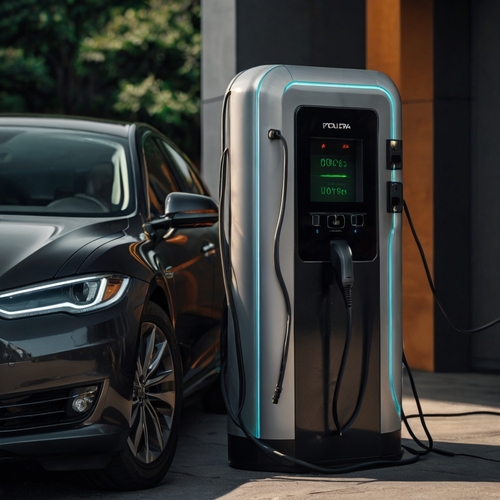The Future of the EV Charger Market in 2031

Strong 8k brings an ultra-HD IPTV experience to your living room and your pocket.
As the world increasingly turns to electric vehicles (EVs) as a solution to reduce carbon emissions and combat climate change, the demand for efficient, widespread charging infrastructure is becoming a critical component of this transition. The EV charger market is expected to experience remarkable growth by 2031, driven by innovations in charging technology, government policies, and a growing commitment to sustainability. In this article, we explore the future of the EV charger market, its key drivers, and the technologies that will shape the charging landscape in the coming decade.
The global shift toward electric vehicles is accelerating, with many countries aiming to phase out internal combustion engine (ICE) vehicles in favor of electric models in the next two decades. With EV sales on the rise, the demand for charging infrastructure is also expected to soar. In 2031, the EV charger market will need to support millions of electric vehicles globally, including both personal and commercial vehicles. The widespread adoption of EVs will be directly tied to the availability of charging stations, which will need to be located in urban centers, along highways, at workplaces, and in residential areas.
The growth of the EV charger market will be primarily driven by advancements in charging technology. One of the key areas of innovation will be ultra-fast charging stations, which will drastically reduce charging times. Currently, charging an electric vehicle can take several hours depending on the charger type, but with ultra-fast charging stations, this time will be reduced to under 30 minutes to achieve an 80% charge. By 2031, the majority of public charging stations will support fast-charging capabilities, offering EV owners greater convenience and flexibility. This advancement will be crucial for long-distance travel and daily commuting, making EVs more viable as a primary mode of transportation.
An additional trend that will shape the EV charger market by 2031 is the development of wireless charging technology. This innovation will eliminate the need for cables and connectors, making the charging process more seamless and user-friendly. Wireless chargers will become more common in public spaces such as shopping malls, office buildings, and parking garages, as well as in residential areas. The introduction of wireless charging will revolutionize the charging experience, making it as simple as parking an EV in a designated area without having to physically plug it in. This convenience will drive higher adoption rates of electric vehicles and reduce the burden of maintaining traditional charging equipment.
Moreover, the integration of renewable energy into the EV charger market will be a key trend moving forward. By 2031, many charging stations will be powered by renewable energy sources such as solar and wind. This shift to clean energy will not only reduce the carbon footprint of the EV charger market but also align with the overall goal of creating a sustainable transportation ecosystem. Many governments and private companies are investing in solar-powered charging stations, especially in sunny regions where solar energy can be harnessed efficiently. Additionally, charging stations will be integrated into smart grids, enabling users to charge their EVs during periods of high renewable energy availability, such as during the day when solar power is abundant. This synergy between EV charging and renewable energy will further promote the environmental benefits of electric vehicles.
The role of government policies and incentives in shaping the EV charger market by 2031 cannot be understated. Policymakers around the world are increasingly introducing regulations and initiatives aimed at promoting the adoption of electric vehicles and the expansion of charging infrastructure. Governments are providing financial incentives for businesses and consumers to install EV chargers, including tax credits, rebates, and grants. Some regions are also introducing mandates for automakers to offer a certain percentage of their vehicle lineup as electric models, further driving the need for charging stations. In addition, governments are making investments in public charging networks, ensuring that EVs are accessible to everyone, regardless of location.
By 2031, the EV charger market will see significant investments from both public and private sectors, leading to an expansion of charging infrastructure globally. Urban areas will see dense networks of charging stations, while more remote and rural areas will also benefit from the expansion of charging facilities. Charging stations will be located at strategic points, such as highway rest stops and urban parking garages, ensuring that drivers have access to convenient charging options no matter where they are.
In parallel with these developments, smart charging solutions will also gain traction in the EV charger market. Smart chargers will allow users to monitor their charging progress through mobile apps and make use of features such as scheduling charging times to take advantage of lower electricity rates during off-peak hours. Smart chargers will also enable dynamic pricing, which adjusts the cost of charging based on factors such as grid demand and time of day. This flexibility will make charging more affordable and accessible, especially for users who are looking to optimize their energy consumption.
In conclusion, the EV charger market is set for remarkable growth by 2031, driven by advancements in charging technology, government policies, and a global commitment to sustainability. The introduction of ultra-fast charging stations, wireless charging solutions, renewable energy integration, and smart charging systems will transform the way consumers and businesses think about EV charging. As the adoption of electric vehicles continues to rise, the expansion of the EV charger market will be crucial in making electric mobility more convenient, accessible, and sustainable. The forecast for 2031 paints a picture of a cleaner, greener, and more connected transportation future, where electric vehicles and their charging infrastructure play a central role in shaping the world’s transportation landscape.
Note: IndiBlogHub features both user-submitted and editorial content. We do not verify third-party contributions. Read our Disclaimer and Privacy Policyfor details.


